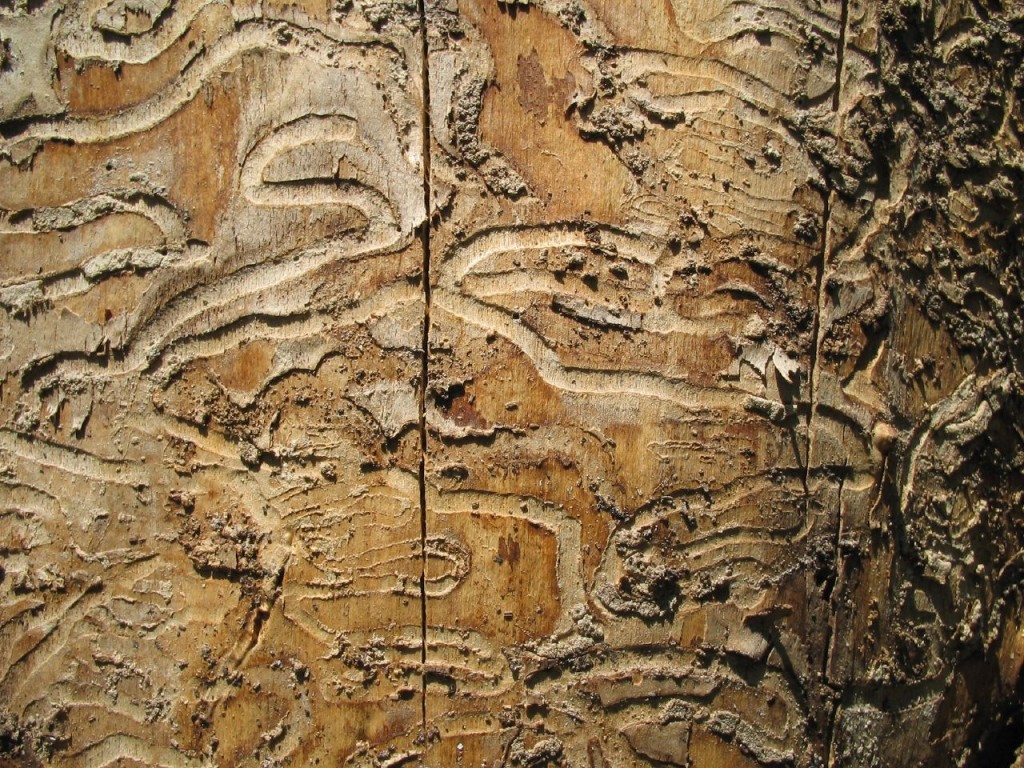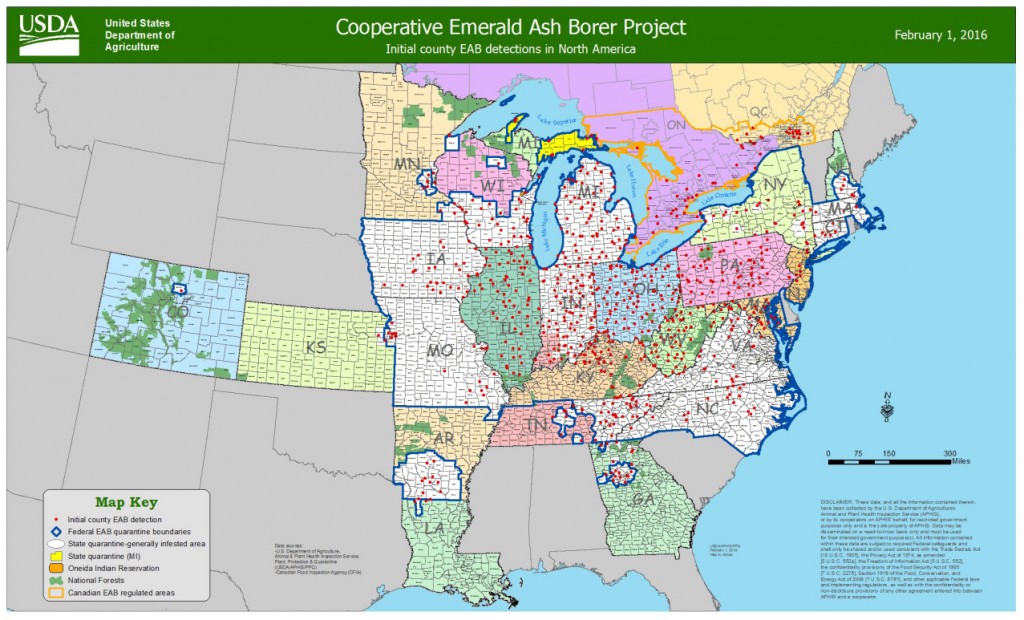It’s little, it’s green, it’s 100% lethal, and it’s just across the river
Kermit the Frog may have lamented “It’s not easy bein’ green,” but these days, everyone wants to market themselves as “green.” It seems to make us feel good. You might recall that during the early 1990s, the lawn-care giant ChemLawn faced a rising public backlash against pesticides as the risks related to their use became widely known. Then with the help of some green paint for their trucks, and a pile of trademark lawyers, ChemLawn morphed into TruGreen, and just like that people started to like them better.

Emerald ash borer. This pricey import will cost us billions. Photo: Macroscopic Solutions, Creative Commons, some rights reserved
If “green” is a hot brand, then “emerald” must be tops. Who doesn’t like the Emerald Isle or the Emerald City, and now the Bahia Emerald is on sale for around $400 mil if you’re looking for a bargain. So right out of the box, the emerald ash borer (EAB) is ahead in the PR department. Plus, it’s gorgeous: a tiny streamlined beetle sporting a metallic green paint job with copper highlights. This, coupled with the fact that they’re not at the moment raining from the sky like a plague of locusts, may be why it’s hard to take the EAB threat seriously. But I’m betting a little “tea” will let the air out of EAB’s greenwash balloon.
Proximity. Right now, the entire northern shore of the St. Lawrence River from the Thousand Islands to Cornwall and beyond is heavily infested with the emerald ash borer. Some islands on the Canadian side are infested as well. This puts EAB within a mile—considerably less in some spots—of St. Lawrence County along a roughly 70-mile stretch of its border. Once they emerge in late spring, EAB often fly between 2 and 3 miles to find new egg-laying sites, and research concludes that they are capable of flying nonstop for 20 miles.
The New York State Department of Environmental Conservation’s EAB Risk Metric considers areas within 5 miles of an infestation center to be at severe risk of EAB invasion, and anything between 5 and 10 miles at high risk. In other words, according to the NYSDEC, St. Lawrence County residents who live within 9 miles of the Seaway are in a high-risk EAB zone, and those within 4 miles of the river are in a severe-risk EAB zone.
Certainty. While EAB is almost surely here already (typically it takes 5-7 years for symptoms to show up, but after that, tree mortality escalates rapidly), it will get here, period. This is not an “if” situation.
Liability. When an ash tree is killed by EAB, the wood degrades unlike anything we have seen before, with the wood losing 500% of its shear strength in 12 to 18 months. This is worth repeating: an EAB-killed tree undergoes a 500% strength loss in as little as one year. Such trees can collapse under their own weight with no causal factor. Trees on private property, as well as those in public rights-of-way, become hazardous if not removed promptly. If your tree is within striking distance of a sidewalk, road, utility line, or footpath, you may be liable.

Emerald ash borer damage. “All native ash trees not chemically treated will be killed by EAB. End of story; no survivors.” Photo: John Hritz, Creative Commons, some rights reserved
Totality. All native ash trees (i.e. those in the genus Fraxinus) not chemically treated will be killed by EAB. End of story; no survivors.
Exorbitancy. Because of the strength-loss phenomenon, removing an infested tree always costs more than taking out a live one, sometimes by an order of magnitude. In many cases, treating an ash which is now in good condition can be cheaper in the long run than removal. However, plans must be made well in advance. It is very important to note that doing nothing is the most expensive option. Personal-injury lawsuits frequently exceed insurance payouts; just a single judgment could bankrupt a town, village, business or individual.
Formed in 2016, the St. Lawrence County Emerald Ash Borer Task Force (EABTF) is a volunteer group composed of local, county and state employees, college and university staff and faculty, tree-care professionals, and other land-management professionals. The goal of the EABTF is to help communities in St. Lawrence County prepare for the impending EAB infestation.
Community needs include quantifying the ash trees for which they are responsible, identifying alternatives for treatment and removal, and selecting the options that best match their needs and budget. In addition, the EABTF wants to help coordinate equipment sharing and dumpsite consolidation, and facilitate ash treatment and removal group bids in order to secure the lowest prices, and to streamline logistics in general. It is also committed to educating the public about EAB and how to best prepare for it.
The St. Lawrence County Emerald Ash Borer Task Force is looking for citizen volunteers to help their communities conduct tree inventories between September 2017 and October 2018. A day-long training is required before field work can begin, and the task force will provide field supervision as needed, and will be available to answer any questions that may arise.
If you, or your civic, church, school or professional group would like more information on this, please email Paul Hetzler at [email protected] or John Tenbusch at [email protected]
Read more about the NYSDEC’s EAB Risk Metric in the Emerald Ash Borer Management Response Plan.
Paul Hetzler is a horticulture and natural resources educator with Cornell Cooperative Extension of St. Lawrence County.









Time for chemical warfare against Canada. If that doesn’t work, Nuke Canada to stop the invaders.
It’s a most frightening eventuality. Parts of the County have forested lands that look to be more than 75% ash, and the loss of these trees will leave us with a bit of a disaster. A forest decimated to this extent could take 50 to 100 years to recover.
Could you please link our image to http://www.macroscopicsoltuions.com if you’re going to use it? Our images are provided via creative commons, but we still ask users to contact us for the appropriate permissions.
I’ll bet you think that’s cute Pete. But it’s no help at all.
Actually, EAB first appeared in Michigan, so Canada got EAB from us. It’s just come full circle.
Hi Mark–
My apologies for missing the website attribution. I have redirected the link to your site. Most Creative Commons photos we use don’t provide an alternative link to be credited, so our standard practice for CC attribution is to credit by linking back to the original photo in the source’s Flickr photostream. Dale Hobson, NCPR